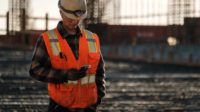Construction projects are increasingly complex. Success depends on our ability to evolve. The right mix of good people equipped with relevant technology ignites progress. At Pepper, progress is powered by a focus on possibilities. We ask, “What if?”
When Pepper started exploring integrated project delivery, we asked, “What if we go beyond what is typically done. What if we approach projects in terms of one plan, one model, one integrated team?” The answers led us to rework our organizational structure and adapt our overall approach to projects in a completely different way.
We created Pepper’s Integrated Construction Services group as a vital part of our applied solution. ICS Integrates technology, higher performance, sustainability and preconstruction, creating a higher level of close collaboration among all disciplines early in a project timeline — one grounded in sharing ideas and respect for each other’s viewpoints.
Collaboration has been a core Pepper value over the decades and across the generations working together in our offices today. Knowing that technology is driving construction forward, and it’s only as good as the people who manage it, we leveraged what differentiates us. We asked, “What if we paired the right technology with good people?”
Our “what if” became a “how to” toward the ultimate goal of optimizing efficiency and maximizing value for our clients. Our answer: inclusion and education.
Investing in deliberate, controlled roll-out of new technologies, educating our trades, mentoring, introducing advances, rather than making any singular drastic change, has Pepper on the forefront of virtual design and construction. We’re combining preconstruction and scheduling services with building technology tools such as 3D BIM, the Microsoft HoloLens and infrared scanning, and setting a new bar for integrating high-performance and sustainability into every project we build. We’re visualizing our data through project dash-boarding and tying in predictive analytics. We’re using Microsoft HoloLens for everything from helping people understand what a space is going to look like, to QA/QC-ing the progress and installation, to understanding logistics.
Jen Suerth, vice president of technical services at Pepper, says, “We’re using technology to change how we perform construction, but the technology is just the tool to achieve our goal.”
Equipping our People with Access that Powers Leadership
We asked, “what if we integrated our high-performance expertise into our operational process — including our job sites?” Pepper’s Net-Zero trailer is the result of a group effort from our ICS team that brought others together with new technologies, like the HoloLens augmented reality headset to build the trailer without paper drawings. Because it was built in our warehouse, any teammate could gain first-hand understanding of the technology in the context of a project before being asked to use it on a jobsite.
The trailer works holistically as one system to reduce heat absorption, increase energy efficiency, eliminate temperature swings, and produce the electricity needed for a full workday, as well as inspire new thinking about what’s possible.
Improving Practices to Reduce Dangerous Utility Strikes
We asked, “what if we engage our trade partners in open dialogue about what’s working and what isn’t?”
Getting feedback directly from the people regularly involved in underground work enabled us to sensibly integrate virtual reality, including drones for aerial photos and 3D models for coordination, and create an underground utility damage prevention strategy that is setting a new standard for safety.
With 63% of utility strikes occurring because of insufficient practices, the tangible reality is prime — reduced risk of injury, death, delays, line damage, fines and costly repairs.
Contractors + Clients
Building a new 200,000-sq-ft housing and academic facility at the University of Illinois at Chicago, we asked, “what if we bring together our client and Pepper teams to envision the project from any point on the site and timeline?”
With outdoor-rated high-bandwidth connectivity deployed on the jobsite, we created a 3D laser scan of each floor before and concrete was placed on time and with cost savings. Streamlining the movement of data to real time, or practically real time, increased efficiencies. Being able to open Tekla and Revil models anywhere onsite put foremen and engineering technicians on the same page with immediate and accurate material data.
When you think about how much we rely on vast amounts of digital data to plan and deliver quality projects, it makes sense to make technology work for the team in the field.
Building relationships and thoughtfully integrating technology to add value is a constant navigation of what makes sense. If we’re going to make positive change for our clients, our organization, and the industry at large, we have to consciously ask questions that lead to opportunity. How to turn those opportunities into reality? Great people and the right technology – this combination leads to breakthroughs in realizing a future built on quality.
Father and son Stan and Jake Pepper are president and CEO and vice president of integrated construction services, respectively, at Pepper Construction in Chicago.





Post a comment to this article
Report Abusive Comment